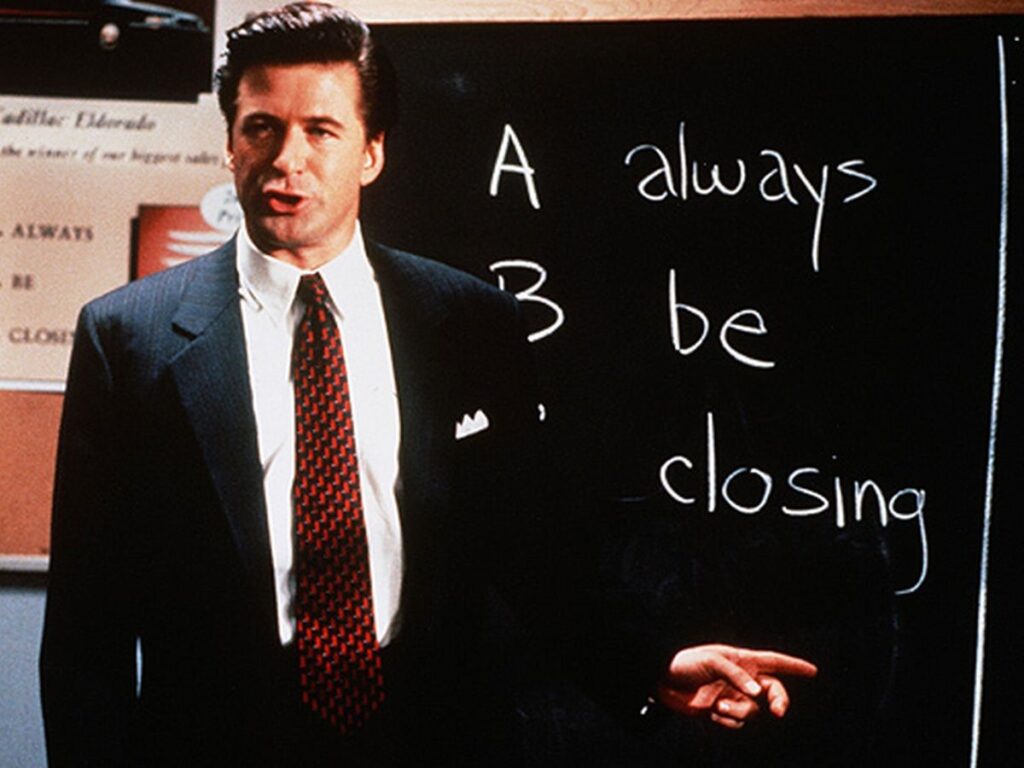I’m sure if you haven’t seen, you’ve at least heard of the infamous sales scene from the 1992 film Glengarry Glen Ross. But if you haven’t, in this particular scene the character played by Alec Baldwin rants for 7+ minutes on why the under-motivated real estate agents should “Always Be Closing.”

The scene itself is harsh, but Alec Baldwin’s monologue is timeless. However, does it offer anything that applies to ecommerce? Can we learn anything from this gregarious display of sales passion? Well, in part, yes.
Closing is important in digital commerce. In fact, it’s essential in driving business growth. Your site experience must be set up in a way that meets and exceeds your customers’ shopping experience expectations and is conducive to driving conversions. The workflows and navigational paths must be aligned with how your customers want to shop, not how you think they should shop. But how do you achieve this? How can you always be closing on your ecommerce website? What’s the best way to know what your customers want? The answer: Always Be Listening.
I firmly believe you can’t achieve ABC without ABL, and here’s why. Customers are essential because, without them, you wouldn’t be able to keep the lights on, but you must also be listening to your employees, as they are equally as important. In this new technological age, your employees are leveraging your commerce site just as much as your customers are for product research, quotes, company updates, etc. You want the experience to be easy for your employees to navigate for their purposes, as well as built to be a seamless experience for your customers as well. So, how can you tackle both and listen to find out how to build a new site or implement new commerce features to meet the needs of all parties? Let’s take a look.
Voice of the Customer (VOC)
VOC is likely something you’re very familiar with, and as I see it, there are two use cases for this within the ecommerce realm. Pre, and post go-live.
Pre-Launch VOC
Before launching your new ecommerce site, it’s essential to speak with key customers on what’s working, what isn’t, and how they’d like to see things improve or change. Gathering their feedback will help to ensure that you’re building a platform that truly fits their needs and expectations. Here are some ways to do that:
- Focus Groups – Identify specific customers that you have to speak about your current site. These customers should have different personas and if you’re in B2B, they should be different types of customers.
- Surveys – Create surveys that can be sent to customers asking them about your current platform and for their thoughts/suggestions.
Post-Launch VOC
After launching, the feedback gathering shouldn’t stop; if anything it should and will increase over time. Here are some ways to think about this:
- Checkout Feedback – At the end of the checkout process, it’s a good idea to provide users with a small on-site survey on how their ordering experience was. Give them options to provide feedback if they so choose.
- Business Reviews – If you have a sales team supporting your business, make part of their customer-facing business reviews focused on feedback on their ordering experiences.
- Feature Voting – As you groom your backlog and build new user stories around site enhancements, allow your customers to provide feedback on some of the high-end areas you’re working on.
Voice of the Employee (VOE)
If you’re building a new commerce site, it’s likely that your employees (especially sales and CSRs) may feel threatened by the technology that “could replace me and do my job.” However, in most cases, this just isn’t true. The new site should free up the sales and CSR teams to spend more time on their customers and deliver better services and additional value adds.
The best way to avoid this mindset with your employees is to take the TCT approach:
- Transparency – Be open and honest with your team. “This site isn’t replacing you, in fact, we will be hiring more, we want you to be a part of this process, and we value your opinions.” Being open and honest about what the project is, what it aims to achieve, and how your employees can help will break down any walls they have put up and help you create the best possible commerce instance.
- Collaboration – Involve specific team members in the building process. Ask them what they are hearing from their customers, what’s working today within the current site, and what isn’t. By gathering their feedback and putting their suggestions into the project plan, you will empower your employees and create a collaborative environment that yields creative suggestions.
- Training – Finally, train your employees on the new commerce site once it has been completed. They should be your “super users.” By training them to be ambassadors of this finished product, they will be able to help train and articulate the specific features of the site to your customers and will help drive up adoption rates.
Remember, you can’t “Always Be Closing” without first adopting the mindset of “Always Be Listening.” To get the close and capture a customer’s order, you first need to listen to how exactly they want to interact with your platform, how they want to place that order, and how they expect your commerce experience to be built in order to make their life easier when purchasing. By listening before and after the site is live, you open the avenue for continuous feedback from both your customers and your employees.
In 1997 Steve Jobs said that “You’ve got to start with the customer experience, and work backwards to the technology.” Start first with what your customers and employees are demanding and asking for, then look to leverage the technology to incorporate their feedback into a platform that is conducive for you to “Always Be Closing.”
At Perficient, we continually look for ways to champion and challenge our talented workforce with interesting projects for high-profile clients, encourage personal and professional growth through training and mentoring, and celebrate our people-oriented culture and the innovative ways they serve Perficient and the community.
Learn more about what it’s like to work at Perficient at our Careers page.
Go inside Life at Perficient and connect with us on LinkedIn, YouTube, Twitter, and Instagram.
